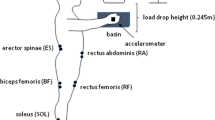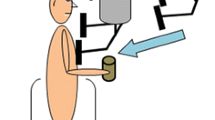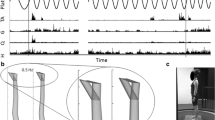Abstract
Anticipatory postural adjustments (APAs) play an important role in the performance of many activities requiring the maintenance of vertical posture. However, little is known about how children utilize APAs during self-induced postural perturbations. A group of children, aged 7–16 years, with typical motor development, performed various arm movements while standing on a force platform. APAs were measured by recording the electromyographic activity of six trunk and leg muscles on both sides of the body and displacement of center of pressure (COP). Anticipatory bursts of activity in the dorsal muscle groups of the trunk and legs and suppression in the ventral muscle groups as well as posterior COP displacement were found during the performance of bilateral shoulder flexion. Conversely, during bilateral shoulder extension, the COP displacement was anterior, and APAs were reversed showing bursts of activity in the ventral muscle groups and suppression in the dorsal muscles. During right and left reciprocal arm movements, COP displacement was minimal and APAs were generated in the dorsal muscle groups on the side of the forward moving arm and in the ventral muscle groups on the side of the arm moving into extension. However this pattern reversed for lower leg muscles, where APAs were generated in the ventral muscles on the side of forward moving arm and in the dorsal muscle on the side of the arm moving into extension. The results of this study indicate that children with typical motor development are able to generate APAs, produce task-specific sequencing of muscle activity and differentiate between perturbations in the sagittal and transverse planes. The results of this study indicate that by at least age 7, children who are typically developing demonstrate the ability to generate patterns of anticipatory muscle activation and suppression, along with center of pressure changes, similar to those reported in healthy adults.









Similar content being viewed by others
References
Adkin AL, Frank JS et al (2002) Fear of falling modifies anticipatory postural control. Exp Brain Res 143(2):160–170
Alexandrov AV, Frolov AA et al (2005) Feedback equilibrium control during human standing. Biol Cybern 93(5):309–322
Angulo-Barroso RM, Wu J et al (2008) Long-term effect of different treadmill interventions on gait development in new walkers with Down syndrome. Gait Posture 27(2):231–238
Aruin AS, Latash ML (1995a) Directional specificity of postural muscles in feed-forward postural reactions during fast voluntary arm movements. Exp Brain Res 103(2):323–332
Aruin AS, Latash ML (1995b) The role of motor action in anticipatory postural adjustments studied with self-induced and externally triggered perturbations. Exp Brain Res 106(2):291–300
Aruin AS, Nicholas JJ et al (1997) Anticipatory postural adjustments during standing in below-the-knee amputees. Clin Biomech (Bristol, Avon) 12(1):52–59
Aruin AS, Forrest WR et al (1998) Anticipatory postural adjustments in conditions of postural instability. Electroencephalogr Clin Neurophysiol 109(4):350–359
Aruin AS, Ota T et al (2001a) Anticipatory postural adjustments associated with lateral and rotational perturbations during standing. J Electromyogr Kinesiol 11(1):39–51
Aruin AS, Shiratori T et al (2001b) The role of action in postural preparation for loading and unloading in standing subjects. Exp Brain Res 138(4):458–466
Assaiante C, Woollacott M et al (2000) Development of postural adjustment during gait initiation: kinematic and EMG analysis. J Mot Behav 32(3):211–226
Barela JA, Jeka JJ et al (1999) The use of somatosensory information during the acquisition of independent upright stance. Infant Motor Behavior 22(1):87–102
Basmajian JV (1980) Electromyography–dynamic gross anatomy: a review. Am J Anat 159(3):245–260
Belen’kii VE, Gurfinkel VS et al (1967) Control elements of voluntary movements. Biofizika 12(1):135–141
Bleuse S, Cassim F et al (2005) Vertical torque allows recording of anticipatory postural adjustments associated with slow, arm-raising movements. Clin Biomech (Bristol, Avon) 20(7):693–699
Bouisset M, Zattara M (1981) A sequence of postural reactions precedes voluntary movements. Neurosci Lett 22:263–270
Bouisset S, Zattara M (1987) Biomechanical study of the programming of anticipatory postural adjustments associated with voluntary movement. J Biomech 20(8):735–742
Bouisset S, Richardson J et al (2000) Do anticipatory postural adjustments occurring in different segments of the postural chain follow the same organisational rule for different task movement velocities, independently of the inertial load value? Exp Brain Res 132(1):79–86
Burtner PA, Woollacott MH et al (1999) Stance balance control with orthoses in a group of children with spastic cerebral palsy. Dev Med Child Neurol 41(11):748–757
Dickstein R, Shefi S et al (2004) Anticipatory postural adjustment in selected trunk muscles in post stroke hemiparetic patients. Arch Phys Med Rehabil 85(2):261–267
Dufosse M, Hugon M et al (1985) Postural forearm changes induced by predictable in time or voluntary triggered unloading in man. Exp Brain Res 60(2):330–334
Friedli WG, Hallett M et al (1984) Postural adjustments associated with rapid voluntary arm movements 1. Electromyographic data. J Neurol Neurosurg Psychiatry 47(6):611–622
Gantchev GN, Dimitrova DM (1996) Anticipatory postural adjustments associated with arm movements during balancing on unstable support surface. Int J Psychophysiol 22(1–2):117–122
Grasso R, Assaiante C et al (1998) Development of anticipatory orienting strategies during locomotor tasks in children. Neurosci Biobehav Rev 22(4):533–539
Haas G, Diener HC et al (1989) Development of feedback and feedforward control of upright stance. Dev Med Child Neurol 31(4):481–488
Hadders-Algra M, Brogren E et al (1998) Development of postural control–differences between ventral and dorsal muscles? Neurosci Biobehav Rev 22(4):501–506
Hahn ME, Farley AM et al (2005) Neural network estimation of balance control during locomotion. J Biomech 38(4):717–724
Hay L, Redon C (1999) Feedforward versus feedback control in children and adults subjected to a postural disturbance. Exp Brain Res 125(2):153–162
Hay L, Redon C (2001) Development of postural adaptation to arm raising. Exp Brain Res 139(2):224–232
Hedberg A, Carlberg EB et al (2005) Development of postural adjustments in sitting position during the first half year of life. Dev Med Child Neurol 47(5):312–320
Hedberg A, Schmitz C et al (2007) Early development of postural adjustments in standing with and without support. Exp Brain Res 178(4):439–449
Henry SM, Fung J et al (1998) EMG responses to maintain stance during multidirectional surface translations. J Neurophysiol 80(4):1939–1950
Hodges PW, Cresswell AG et al (2000) Three dimensional preparatory trunk motion precedes asymmetrical upper limb movement. Gait Posture 11(2):92–101
Horak FB, Dimitrova D et al (2005) Direction-specific postural instability in subjects with Parkinson’s disease. Exp Neurol 193(2):504–521
Jover M, Schmitz C et al (2006) Anticipatory postural adjustments in a bimanual load-lifting task in children with Duchenne muscular dystrophy. Neurosci Lett 403(3):271–275
Jucaite A, Fernell E et al (2003) Deficient coordination of associated postural adjustments during a lifting task in children with neurodevelopmental disorders. Dev Med Child Neurol 45(11):731–742
Latash ML, Aruin AS et al (1995) Anticipatory postural adjustments during self inflicted and predictable perturbations in Parkinson’s disease. J Neurol Neurosurg Psychiatry 58(3):326–334
Ledebt A, Bril B et al (1998) The build-up of anticipatory behaviour. An analysis of the development of gait initiation in children. Exp Brain Res 120(1):9–17
Lee LJ, Coppieters MW et al (2009) Anticipatory postural adjustments to arm movement reveal complex control of paraspinal muscles in the thorax. J Electromyogr Kinesiol 19(1):46–54
Li X, Aruin AS (2008) Anticipatory postural adjustments in conditions of simulated reduced gravity. Gait Posture 28(4):538–544
Liu W, Zaino CA et al (2007) Anticipatory postural adjustments in children with cerebral palsy and children with typical development. Pediatr Phys Ther 19:188–195
Macpherson JM, Horak FB et al (1989) Stance dependence of automatic postural adjustments in humans. Exp Brain Res 78(3):557–566
Maki BE, McIlroy WE (1996) Postural control in the older adult. Clin Geriatr Med 12(4):635–658
Malouin F, Richards CL (2000) Preparatory adjustments during gait initiation in 4–6-year-old children. Gait Posture 11(3):239–253
Martineau J, Schmitz C et al (2004) Impairment of a cortical event-related desynchronisation during a bimanual load-lifting task in children with autistic disorder. Neurosci Lett 367(3):298–303
Massion J (1992) Movement, posture and equilibrium: interaction and coordination. Prog Neurobiol 38(1):35–56
McFadyen BJ, Malouin F et al (2001) Anticipatory locomotor control for obstacle avoidance in mid-childhood aged children. Gait Posture 13(1):7–16
Park S, Horak FB et al (2004) Postural feedback responses scale with biomechanical constraints in human standing. Exp Brain Res 154(4):417–427
Riach CL, Hayes KC (1987) Maturation of postural sway in young children. Dev Med Child Neurol 29(5):650–658
Riach CL, Hayes KC (1990) Anticipatory postural control in children. J Mot Behav 22(2):250–266
Riach C, Lucy SD (1987) Adjustments to posture prior to arm movement. In: Jonsson B et al (eds) International series on biomechanics, biomechanic X-A. Human Kinetics, Champaign, pp 459–463
Roncesvalles MN, Woollacott MH et al (2001) Development of lower extremity kinetics for balance control in infants and young children. J Mot Behav 33(2):180–192
Santos MJ, Aruin AS (2008) Effects of lateral perturbations and changing stance conditions on anticipatory postural adjustment. J Electromyogr Kinesiol
Santos MJ, Kanekar N et al (2010) The role of anticipatory postural adjustments in compensatory control of posture: 1. Electromyographic analysis. J Electromyogr Kinesiol 20(3):388–397
Schmitz C, Martin N et al (1999) Development of anticipatory postural adjustments in a bimanual load-lifting task in children. Exp Brain Res 126(2):200–204
Schmitz C, Martin N et al (2002) Building anticipatory postural adjustment during childhood: a kinematic and electromyographic analysis of unloading in children from 4 to 8 years of age. Exp Brain Res 142(3):354–364
Schmitz C, Martineau J et al (2003) Motor control and children with autism: deficit of anticipatory function? Neurosci Lett 348(1):17–20
Shiratori T, Aruin AS (2004) Anticipatory postural adjustments associated with rotational perturbations while standing on fixed and free-rotating supports. Clin Neurophysiol 115(4):797–806
Shiratori T, Latash M (2000) The roles of proximal and distal muscles in anticipatory postural adjustments under asymmetrical perturbations and during standing on rollerskates. Clin Neurophysiol 111(4):613–623
Shiratori T, Latash ML (2001) Anticipatory postural adjustments during load catching by standing subjects. Clin Neurophysiol 112(7):1250–1265
Shumway-Cook A, Woollacott MH (1985) The growth of stability: postural control from a development perspective. J Mot Behav 17(2):131–147
Shumway-Cook A, Hutchinson S et al (2003) Effect of balance training on recovery of stability in children with cerebral palsy. Dev Med Child Neurol 45(9):591–602
Slijper H, Latash M (2000) The effects of instability and additional hand support on anticipatory postural adjustments in leg, trunk, and arm muscles during standing. Exp Brain Res 135(1):81–93
Sveistrup H, Woollacott MH (1996) Longitudinal development of the automatic postural response in infants. J Mot Behav 28(1):58–70
Sveistrup H, Woollacott MH (1997) Practice modifies the developing automatic postural response. Exp Brain Res 114(1):33–43
Ulrich DA, Lloyd MC et al (2008) Effects of intensity of treadmill training on developmental outcomes and stepping in infants with Down syndrome: a randomized trial. Phys Ther 88(1):114–122
Vallis LA, McFadyen BJ (2005) Children use different anticipatory control strategies than adults to circumvent an obstacle in the travel path. Exp Brain Res 167(1):119–127
van der Fits IB, Klip AW et al (1999a) Postural adjustments during spontaneous and goal-directed arm movements in the first half year of life. Behav Brain Res 106(1–2):75–90
van der Fits IB, Otten E et al (1999b) The development of postural adjustments during reaching in 6- to 18-month-old infants. Evidence for two transitions. Exp Brain Res 126(4):517–528
Westcott SL, Burtner PA (2004) Postural control in children: implications for pediatric practice. Phys Occup Ther Pediatr 24(1–2):5–55
Winter DA, Prince F et al (1996) Unified theory regarding A/P and M/L balance in quiet stance. J Neurophysiol 75(6):2334–2343
Witherington D, von Hofsten C, Rosander K, Robinette A, Woollacott MW, Bertenthal BI (2002) The developmental of anticipatory postural adjustments in infancy. Infancy 3(4):495–517
Woollacott M, Shumway-Cook A et al (2005) Effect of balance training on muscle activity used in recovery of stability in children with cerebral palsy: a pilot study. Dev Med Child Neurol 47(7):455–461
Wu J, Looper J et al (2007) Exploring effects of different treadmill interventions on walking onset and gait patterns in infants with Down syndrome. Dev Med Child Neurol 49(11):839–845
Wu J, Ulrich DA et al (2008) Strategy adoption and locomotor adjustment in obstacle clearance of newly walking toddlers with Down syndrome after different treadmill interventions. Exp Brain Res 186(2):261–272
Zattara M, Bouisset S (1988) Posturo-kinetic organisation during the early phase of voluntary upper limb movement. 1. Normal subjects. J Neurol Neurosurg Psychiatry 51(7):956–965
Acknowledgments
We would like to thank the children and families who participated in this study and also Shruti Joshi, PT, MS, Xioyan Li, PhD, Marcio Santos, PT, PhD and Veena Iyengar, PT, MS for assistance with data collection. This study was supported in part by a grant from the Neuro-Developmental Treatment Association, Laguna Beach, CA.
Author information
Authors and Affiliations
Corresponding author
Rights and permissions
About this article
Cite this article
Girolami, G.L., Shiratori, T. & Aruin, A.S. Anticipatory postural adjustments in children with typical motor development. Exp Brain Res 205, 153–165 (2010). https://doi.org/10.1007/s00221-010-2347-7
Received:
Accepted:
Published:
Issue Date:
DOI: https://doi.org/10.1007/s00221-010-2347-7




